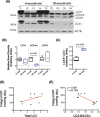Autophagy in the Aging and Experimental Ocular Hypertensive Mouse Model
- PMID: 32797200
- PMCID: PMC7441338
- DOI: 10.1167/iovs.61.10.31
Autophagy in the Aging and Experimental Ocular Hypertensive Mouse Model
Abstract
Purpose: To investigate autophagy in the outflow pathway and ganglion cell layer in the aging and ocular hypertensive mouse.
Methods: Both 4-month-old and 18-month-old C57BL/6J and GFP-LC3 mice were subjected to unilateral injection of hypertonic saline into a limbal vein, causing sclerosis of the outflow pathway and subsequent elevation of intraocular pressure (IOP). IOP was measured on a weekly basis using a rebound tonometer. Protein expression levels of LC3B, Lamp1, and p62 were evaluated by western blot and/or immunofluorescence. Retinal ganglion cell (RGC) count was performed in whole retinal flat mounts using an anti-Brn3a antibody. Optic nerves were fixed with 4% paraformaldehyde and resin-embedded for axon counts and electron microscopy.
Results: In contrast to 18-month-old mice, which developed sustained elevated IOP with a single injection, 4-month-old mice were refractory to high elevations of IOP. Interestingly, both the percentage of animals that developed elevated IOP and the mean ∆IOP were significantly higher in the transgenic mice compared to C57BL/6J. Immunofluorescence and western blot analysis showed dysregulated autophagy in the iridocorneal and retina tissues from 18-month-old mice compared to 4-month-old ones. Moreover, the LC3-II/LC3-I ratio correlated with IOP. As expected, injected hypertensive eyes displayed axonal degeneration and RGC death. RGC and axon loss were significantly exacerbated with aging, especially when combined with GFP-LC3 expression. Autophagic structures were observed in the degenerating axons.
Conclusions: Our results indicate dysregulation of autophagy in the trabecular meshwork and retinal tissues with aging and suggest that such dysregulation of autophagy contributes to neurodegeneration in glaucoma.
Conflict of interest statement
Disclosure:
Figures






References
-
- Tombran-Tink J, Barnstable CJ, Shields MB, eds. Mechanisms of the glaucomas: disease processes and therapeutic modalities. Totowa, NJ: Humana Press; 2008.
-
- Chen DF, Cho K-S. Optic neuropathy and ganglion cell degeneration in glaucoma: mechanisms and therapeutic strategies. In: Tombran-Tink J Barnstable CJ, Shields BM, eds. Mechanisms of the glaucomas. Totowa, NJ: Humana Press; 2008: 393–423.
-
- Beckman KB, Ames BN. The free radical theory of aging matures. Physiol Rev. 1998; 78: 547–581. - PubMed
Publication types
MeSH terms
Substances
Grants and funding
LinkOut - more resources
Full Text Sources
Medical
Molecular Biology Databases
Research Materials
Miscellaneous

